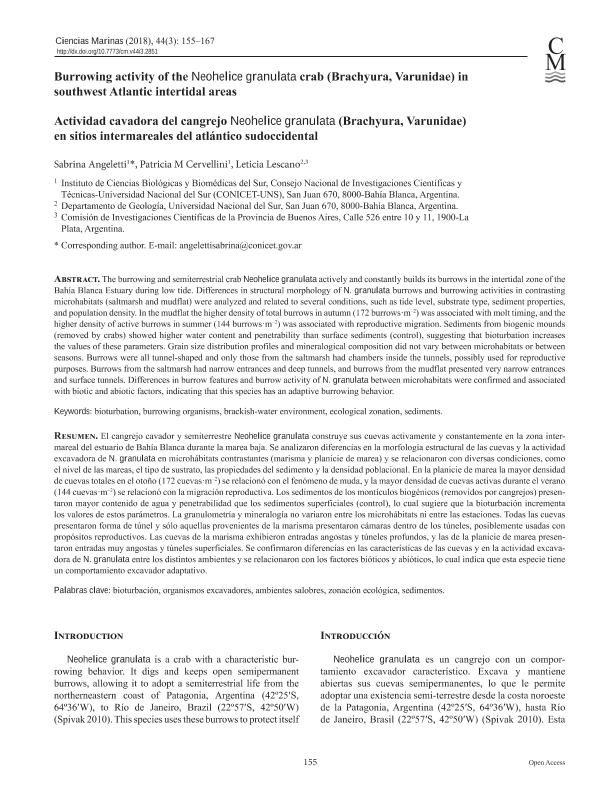Artículo
The burrowing and semiterrestrial crab Neohelice granulata builds its burrows actively and constantly in the intertidal of the estuary of Bahia Blanca, during low tides. Differences in structural morphology of burrows and their burrowing activities in contrasting microhabitats (saltmarsh and mudflat) were analysed and related to several conditions, such as tide level, substrate type, sediments properties and population density. In mudflat a higher density of total burrows was found in autumn (172 burrows m-2), related to molt timing and a higher density of active burrows in summer (144 burrows m-2), was related to reproductive migration. Sediments collected from biogenic mounds (removed by crabs) had more water content and penetrability than sediment from surface (control), suggesting that bioturbation increases these values. Grain size distribution profiles and mineralogical composition didn?t vary between microhabitats neither between seasons. Burrows were all tunnel-shaped and only those from saltmarshes had chambers inside tunnels, possibly used for reproductive purposes. Burrows from saltmarsh had narrow entrances and deep tunnels and burrows from mudflats presented very narrow entrances and superficial tunnels. Differences in burrow features and burrow activity of Neohelice granulata between microhabitats are confirmed, related to biotic and abiotic factors, indicating that this species has an adaptive burrowing behaviour. El cangrejo cavador y semiterrestre Neohelice granulata construye sus cuevas activamente y constantemente en la zona intermareal del estuario de Bahía Blanca durante la marea baja. Se analizaron diferencias en la morfología estructural de las cuevas y la actividad excavadora de N. granulata en microhábitats contrastantes (marisma y planicie de marea) y se relacionaron con diversas condiciones, como el nivel de las mareas, el tipo de sustrato, las propiedades del sedimento y la densidad poblacional. En la planicie de marea la mayor densidad de cuevas totales en el otoño (172 cuevas·m–2) se relacionó con el fenómeno de muda, y la mayor densidad de cuevas activas durante el verano (144 cuevas·m–2) se relacionó con la migración reproductiva. Los sedimentos de los montículos biogénicos (removidos por cangrejos) presentaron mayor contenido de agua y penetrabilidad que los sedimentos superficiales (control), lo cual sugiere que la bioturbación incrementa los valores de estos parámetros. La granulometría y mineralogía no variaron entre los microhábitats ni entre las estaciones. Todas las cuevas presentaron forma de túnel y sólo aquellas provenientes de la marisma presentaron cámaras dentro de los túneles, posiblemente usadas con propósitos reproductivos. Las cuevas de la marisma exhibieron entradas angostas y túneles profundos, y las de la planicie de marea presentaron entradas muy angostas y túneles superficiales. Se confirmaron diferencias en las características de las cuevas y en la actividad excavadora de N. granulata entre los distintos ambientes y se relacionaron con los factores bióticos y abióticos, lo cual indica que esta especie tiene un comportamiento excavador adaptativo.
Burrowing activity of the Neohelice granulata crab (Brachyura, Varunidae) in southwest Atlantic intertidal areas
Título:
Actividad cavadora del cangrejo Neohelice granulata (Brachyura, Varunidae) en sitios intermareales del atlántico sudoccidental
Fecha de publicación:
09/2018
Editorial:
Universidad Autónoma de Baja California. Instituto de Investigaciones Oceanológicas
Revista:
Ciencias Marinas
ISSN:
0185-3880
Idioma:
Inglés
Tipo de recurso:
Artículo publicado
Clasificación temática:
Resumen
Archivos asociados
Licencia
Identificadores
Colecciones
Articulos(INBIOSUR)
Articulos de INSTITUTO DE CIENCIAS BIOLOGICAS Y BIOMEDICAS DEL SUR
Articulos de INSTITUTO DE CIENCIAS BIOLOGICAS Y BIOMEDICAS DEL SUR
Citación
Angeletti, Sabrina; Cervellini, Patricia Marta; Lescano, Leticia; Burrowing activity of the Neohelice granulata crab (Brachyura, Varunidae) in southwest Atlantic intertidal areas; Universidad Autónoma de Baja California. Instituto de Investigaciones Oceanológicas; Ciencias Marinas; 44; 3; 9-2018; 155-167
Compartir
Altmétricas




